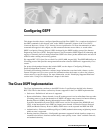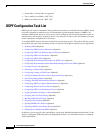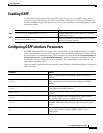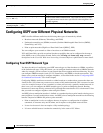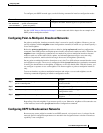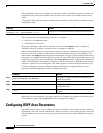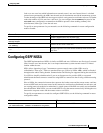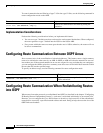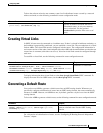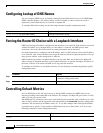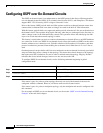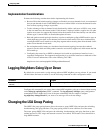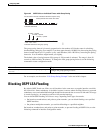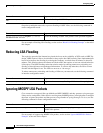
Configuring OSPF
Creating Virtual Links
IPC-231
Cisco IOS IP Configuration Guide
To have the software advertise one summary route for all redistributed routes covered by a network
address and mask, use the following command in router configuration mode:
Creating Virtual Links
In OSPF, all areas must be connected to a backbone area. If there is a break in backbone continuity, or
the backbone is purposefully partitioned, you can establish a virtual link. The two endpoints of a virtual
link are ABRs. The virtual link must be configured in both routers. The configuration information in
each router consists of the other virtual endpoint (the other ABR) and the nonbackbone area that the two
routers have in common (called the transit area). Note that virtual links cannot be configured through
stub areas.
To establish a virtual link, use the following command in router configuration mode:
To display information about virtual links, use the show ip ospf virtual-links EXEC command. To
display the router ID of an OSPF router, use the show ip ospf EXEC command.
Generating a Default Route
You can force an ASBR to generate a default route into an OSPF routing domain. Whenever you
specifically configure redistribution of routes into an OSPF routing domain, the router automatically
becomes an ASBR. However, an ASBR does not, by default, generate a default route into the OSPF
routing domain.
To force the ASBR to generate a default route, use the following command in router configuration mode:
For a discussion of redistribution of routes, see the “Configuring IP Routing Protocol-Independent
Features” chapter.
Command Purpose
Router(config-router)# summary-address {{ip-address mask} |
{prefix mask}} [not-advertise][tag tag]
Specifies an address and mask that covers
redistributed routes, so only one summary
route is advertised. Use the optional
not-advertise keyword to filter out a set of
routes.
Command Purpose
Router(config-router)# area transit-area-id virtual-link transit-router-id
[authentication {message-digest | null}] [hello-interval seconds]
[retransmit-interval seconds] [transmit-delay seconds] [dead-interval seconds]
[{authentication-key key} | message-digest-key key-id | md5 key}]
Establishes a virtual link.
Command Purpose
Router(config-router)# default-information originate
[always] [metric metric-value] [metric-type type-value]
[route-map map-name]
Forces the autonomous system boundary router to
generate a default route into the OSPF routing
domain.



